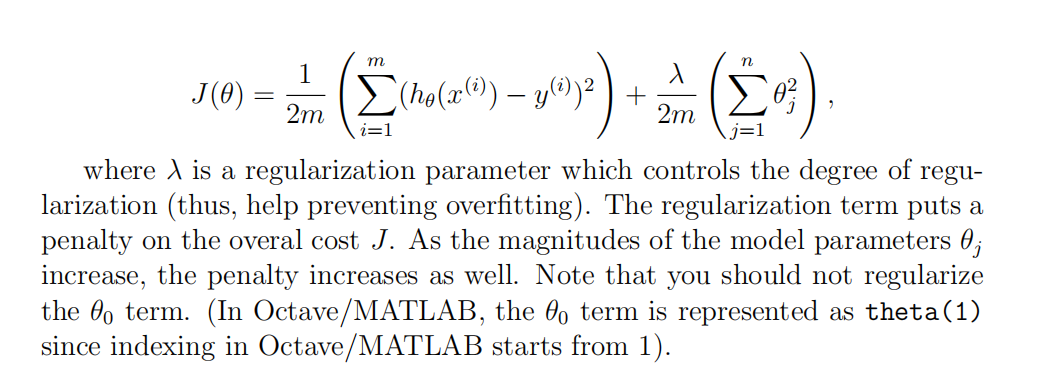1.linearRegCostFunction:


function [J, grad] = linearRegCostFunction(X, y, theta, lambda) %LINEARREGCOSTFUNCTION Compute cost and gradient for regularized linear %regression with multiple variables % [J, grad] = LINEARREGCOSTFUNCTION(X, y, theta, lambda) computes the % cost of using theta as the parameter for linear regression to fit the % data points in X and y. Returns the cost in J and the gradient in grad % Initialize some useful values m = length(y); % number of training examples % You need to return the following variables correctly J = 0; grad = zeros(size(theta)); % ====================== YOUR CODE HERE ====================== % Instructions: Compute the cost and gradient of regularized linear % regression for a particular choice of theta. % % You should set J to the cost and grad to the gradient. % h=(X*theta); for i=1:m, J=J+1/(2*m)*(h(i)-y(i))^2; endfor n= length(theta); for i=2:n, J=J+lambda/(2*m)*theta(i)^2; endfor grad(1)=1/m*(h-y)'*X(:,1); for i=2:n, grad(i)=1/m*(h-y)'*X(:,i)+lambda/m*theta(i); endfor % ========================================================================= grad = grad(:); end
2.learningCuvers

function [error_train, error_val] = ...
learningCurve(X, y, Xval, yval, lambda)
%LEARNINGCURVE Generates the train and cross validation set errors needed
%to plot a learning curve
% [error_train, error_val] = ...
% LEARNINGCURVE(X, y, Xval, yval, lambda) returns the train and
% cross validation set errors for a learning curve. In particular,
% it returns two vectors of the same length - error_train and
% error_val. Then, error_train(i) contains the training error for
% i examples (and similarly for error_val(i)).
%
% In this function, you will compute the train and test errors for
% dataset sizes from 1 up to m. In practice, when working with larger
% datasets, you might want to do this in larger intervals.
%
% Number of training examples
m = size(X, 1);
% You need to return these values correctly
error_train = zeros(m, 1);
error_val = zeros(m, 1);
% ====================== YOUR CODE HERE ======================
% Instructions: Fill in this function to return training errors in
% error_train and the cross validation errors in error_val.
% i.e., error_train(i) and
% error_val(i) should give you the errors
% obtained after training on i examples.
%
% Note: You should evaluate the training error on the first i training
% examples (i.e., X(1:i, :) and y(1:i)).
%
% For the cross-validation error, you should instead evaluate on
% the _entire_ cross validation set (Xval and yval).
%
% Note: If you are using your cost function (linearRegCostFunction)
% to compute the training and cross validation error, you should
% call the function with the lambda argument set to 0.
% Do note that you will still need to use lambda when running
% the training to obtain the theta parameters.
%
% Hint: You can loop over the examples with the following:
%
% for i = 1:m
% % Compute train/cross validation errors using training examples
% % X(1:i, :) and y(1:i), storing the result in
% % error_train(i) and error_val(i)
% ....
%
% end
%
% ---------------------- Sample Solution ----------------------
for i=1:m,
theta=trainLinearReg(X(1:i,:),y(1:i),lambda);
error_train(i)=linearRegCostFunction(X(1:i,:),y(1:i),theta,0);
error_val(i)=linearRegCostFunction(Xval,yval,theta,0);
endfor
% -------------------------------------------------------------
% =========================================================================
end
3.polyFeatures

function [X_poly] = polyFeatures(X, p) %POLYFEATURES Maps X (1D vector) into the p-th power % [X_poly] = POLYFEATURES(X, p) takes a data matrix X (size m x 1) and % maps each example into its polynomial features where % X_poly(i, :) = [X(i) X(i).^2 X(i).^3 ... X(i).^p]; % % You need to return the following variables correctly. X_poly = zeros(numel(X), p); % ====================== YOUR CODE HERE ====================== % Instructions: Given a vector X, return a matrix X_poly where the p-th % column of X contains the values of X to the p-th power. % % for i=1:p, X_poly(:,i)=(X.^i); endfor % ========================================================================= end
4.ValidationCurve

function [lambda_vec, error_train, error_val] = ...
validationCurve(X, y, Xval, yval)
%VALIDATIONCURVE Generate the train and validation errors needed to
%plot a validation curve that we can use to select lambda
% [lambda_vec, error_train, error_val] = ...
% VALIDATIONCURVE(X, y, Xval, yval) returns the train
% and validation errors (in error_train, error_val)
% for different values of lambda. You are given the training set (X,
% y) and validation set (Xval, yval).
%
% Selected values of lambda (you should not change this)
lambda_vec = [0 0.001 0.003 0.01 0.03 0.1 0.3 1 3 10]';
% You need to return these variables correctly.
error_train = zeros(length(lambda_vec), 1);
error_val = zeros(length(lambda_vec), 1);
% ====================== YOUR CODE HERE ======================
% Instructions: Fill in this function to return training errors in
% error_train and the validation errors in error_val. The
% vector lambda_vec contains the different lambda parameters
% to use for each calculation of the errors, i.e,
% error_train(i), and error_val(i) should give
% you the errors obtained after training with
% lambda = lambda_vec(i)
%
% Note: You can loop over lambda_vec with the following:
%
% for i = 1:length(lambda_vec)
% lambda = lambda_vec(i);
% % Compute train / val errors when training linear
% % regression with regularization parameter lambda
% % You should store the result in error_train(i)
% % and error_val(i)
% ....
%
% end
%
%
for i=1:length(lambda_vec),
Lam=lambda_vec(i);
theta=trainLinearReg(X,y,Lam);
error_train(i)=linearRegCostFunction(X,y,theta,0);
error_val(i)=linearRegCostFunction(Xval,yval,theta,0);
endfor
% =========================================================================
end